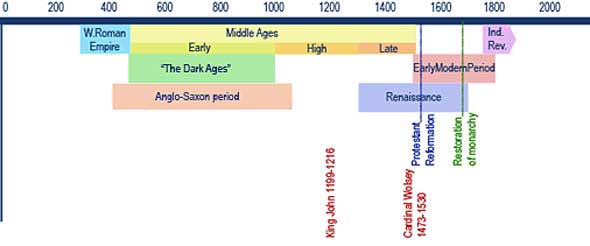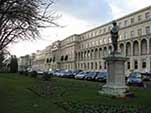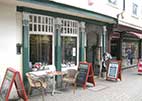Timelines / Architectural styles
See also our Grand Ipswich
timeline for two thousand years of the town's history;
Ipswich
invasions timeline to
see all the raiders and invaders who attacked Ipswich throughout its
history;
also the Christchurch/Holy Trinity Priory
timeline, the Wolsey's
College timeline and the Public transport in Ipswich timeline.
Commonly used terms for
periods of
English
history

Notes
The
Western Roman Empire began
under Diocletian in AD 285 and was periodically abolished and recreated
for the next two centuries until final abolishment by the Byzantine
emperor Zeno in AD 480.
The Anglo-Saxon
period lasted for 600 years, from 410 to 1066. This can be broken down
into: Early Anglo-Saxon period (410–660), Middle Anglo-Saxon period (660–899), Late Anglo-Saxon period (899–1066). Some people's
shorthand refers to 'Middle Saxon period', for example, but we cleave
to the full expression to avoid confusion. Ipswich was the first
Anglo-Saxon town. Following the Norman Conquest in 1066 Anglo-Saxon
nobility were either exiled or joined the ranks of the peasantry.
The
Middle Ages of Western
Europe are commonly dated from the end of the Western Roman Empire (5th
century) until the rise of national monarchies, the start of European
overseas exploration, the humanist revival, and the Protestant
Reformation starting in 1517 (see below).
1. The Early Middle Ages
—From the fall of Rome in AD 476. To avoid undue emphasis on exact
years, the date is
usually rounded off and the period stated as AD 500-1000 or from the
5th to the 10th centuries. The Early Middle Ages includes the Migration
period (also referred to as the "Dark
Ages" the Early Middle Ages c. 5th–10th century), the
Ostrogoths and Visigoths, the Merovingians, Anglo-Saxon England, the
Frankish Empire and the Viking Age.
2. The High Middle Ages
was the period of European history in the 11th, 12th, and 13th
centuries (AD 1000–1300)
while recognizable nations were forming.
3. The Late Middle Ages generally
describes the period of the 14th and 15th centuries (c.
1300–1500) leading up to the Early Modern period or era; see
also
Early Modern Europe. Broadly, medieval is an
adjective applied to The Middle Ages.
Note that the word 'medieval' is sometimes bandied
around and can cause confusion. Some have
applied it in Britain to the period from 1066 (Norman Conquest) to 1666
(the Great Fire of London). The word medieval
has its origins in the Latin term medium
aevum ("middle age"), and first came into use in the 19th
century, although the idea of a middle age had been around for several
hundred years. At that time, scholars considered the medieval period to
follow the fall of the Roman Empire and precede the Renaissance. This
medieval era had long been ignored as unimportant compared to the time
periods it bridged. Clearly, exact dates for named eras can be
challenged and transitions are fluid, depending on which historian one
consults.
The
Renaissance was a cultural
movement that spanned the period roughly from the 14th to the 17th
century, beginning in Italy in the Late Middle Ages and later spreading
to the rest of Europe.
The
Early Modern Period spans
the period after the late portion of the Middle Ages (c. 1500) through
the beginning of the Age of Revolutions (c. 1800).
The Protestant Reformation was
the schism within Western Christianity initiated by Martin Luther, John
Calvin, and other early Protestants (against Roman Catholic orthodoxy).
The date most usually given for the start of the Protestant Reformation
is 1517, when Martin Luther published The
Ninety-Five Theses, and for its conclusion in 1648 with the
Peace of Westphalia that ended the European wars of religion. The
separation of the Church of England (or Anglican Church) from Rome
under Henry VIII, beginning in 1529 and completed in 1537, brought
England alongside this broad Reformation movement; however, religious
changes in the English national church proceeded more conservatively
than elsewhere in Europe. Reformers in the Church of England
alternated, for centuries, between sympathies for ancient Catholic
tradition and more Reformed principles, gradually developing into a
tradition considered a middle way between the Roman Catholic and
Protestant traditions.
The
Industrial Revolution in Britain is described as
a period from 1750 to 1850 when technological innovation,
mechanisation, new work practices (often at the expense of the poorest
in society), the growth of huge industrial cities and other changes led
to the dominance of the seaways
and colonisation of foreign lands, enslavement of workforces and the
establishment of The British Empire under Queen Victoria (reigned
1837-1901). However, many might argue that 'The Industrial Revolution'
continued
for decades after 1850 and has, only in the late 20th century, been
replaced by 'The Digital Revolution' which continues...


Architectural
styles/periods
Bandying
around terms such as 'Palladian' and 'Gothic' is all well and good, but
what do the architectural and design styles and eras mean; what period
do they refer to? This list will undoubtedly grow...

The Queen Anne style in
Britain refers to either the English Baroque architectural style
approximately of the reign of Queen Anne (reigned 1702 to 1714), or a
revived form that was popular in the last quarter of the 19th century
and the early decades of the 20th century (when it is also known as
Queen Anne revival). In British architecture the term is mostly used of
domestic buildings up to the size of a manor house, and usually
designed elegantly but simply by local builders or architects, rather
than the grand palaces of noble magnates.

The Georgian era of
British history is a period which takes its name from, and is normally
defined as spanning the reigns of the first four Hanoverian kings of
Great Britain who were all named George: George I, George II, George
III and George IV. The era covers the period from 1714 to 1830, with
the sub-period of the Regency defined by the Regency of George IV as
Prince of Wales during the illness of his father George III. The
definition of the Georgian era is often extended to include the short
reign of William IV, which ended with his death in 1837. The last
Hanoverian monarch of Great Britain was William's niece Queen Victoria,
who is the namesake of the following historical era, the Victorian,
which is usually defined as occurring from the start of her reign, when
William died, and continuing until her death. The term Georgian is
typically used in the contexts of social history and architecture.

The Regency in Great
Britain was a period when King George III was deemed unfit to rule and
his son ruled as his proxy as ‘Prince Regent’. On the death of George
III in 1820, the Prince Regent became George IV. The term Regency (or
Regency era) can refer to various stretches of time; some are a longer
period than the decade of the formal Regency which lasted from 1811 to
1820. The period 1795 to 1837, which includes the latter part of the
reign of George III and the reigns of his sons George IV and William
IV, is often attributed as the Regency era characterised by distinctive
trends in British architecture, literature, fashions, politics, and
culture. The Regency era ended
in 1837 when Queen Victoria succeeded William IV.

Arts & Crafts movement was an international
movement in the decorative and fine arts that began in Britain and
flourished in Europe and North America between 1880 and 1910. It
advocated economic and social reform and was essentially
anti-industrial. It had a strong influence on the arts in Europe until
it was displaced by Modernism in the 1930s, and its influence continued
among craft makers, designers, and town planners long afterwards. The
term was first used in 1887, although the principles and style on which
it was based had been developing in England for at least twenty years.
It was inspired by the ideas of architect Augustus Pugin (1812-1852),
writer John Ruskin (1819-1900), and artist William Morris (1834-1896). See example: the interior of the Museum Street Methodist Church in Black
Horse Lane.

Art Nouveau is an international
style of art, architecture and applied art, especially the decorative
arts, that was most popular between 1890 and 1910. A reaction to the
academic art of the 19th century, it was inspired by natural forms and
structures, particularly the curved lines of plants and
flowers. Art Nouveau is considered a "total" art style, embracing
architecture, graphic art, interior design, and most of the decorative
arts including jewellery, furniture, textiles, household silver and
other utensils, and lighting, as well as the fine arts. According to
the philosophy of the style, art should be a way of life. For many
well-off Europeans, it was possible to live in an art nouveau-inspired
house with art nouveau furniture, silverware, fabrics, ceramics
including tableware, jewellery, cigarette cases, etc. Artists desired
to combine the fine arts and applied arts, even for utilitarian
objects. See example: Scarborow shop in
Dial Lane shows a Charles Rennie Macintosh-style Art Nouveau frontage
by John Shewell Corder.
 Art Deco: a style of
visual arts, architecture and design that first appeared in France just
before World War I. It became popular in the 1920s and 1930s, and
influenced the design of buildings, furniture, jewellery, fashion,
cars, cinemas, theatres, trains, ocean liners, and everyday objects
such as radios and vacuum cleaners. It took its name, short for Arts
Décoratifs, from the Exposition Internationale des Arts Décoratifs et
Industriels Modernes (International Exhibition of Modern Decorative and
Industrial Arts) held in Paris in 1925. It combined modernist styles
with fine craftsmanship and rich materials. During its heyday, Art Deco
represented luxury, glamour, exuberance, and faith in social and
technological progress. See example: Electric House, Lloyds Avenue,
formerly the Job Centre, The Hogshead, Lloyds Tavern.
Art Deco: a style of
visual arts, architecture and design that first appeared in France just
before World War I. It became popular in the 1920s and 1930s, and
influenced the design of buildings, furniture, jewellery, fashion,
cars, cinemas, theatres, trains, ocean liners, and everyday objects
such as radios and vacuum cleaners. It took its name, short for Arts
Décoratifs, from the Exposition Internationale des Arts Décoratifs et
Industriels Modernes (International Exhibition of Modern Decorative and
Industrial Arts) held in Paris in 1925. It combined modernist styles
with fine craftsmanship and rich materials. During its heyday, Art Deco
represented luxury, glamour, exuberance, and faith in social and
technological progress. See example: Electric House, Lloyds Avenue,
formerly the Job Centre, The Hogshead, Lloyds Tavern.
Modernism.
Modernism was an early 20th-century movement in literature, visual
arts, and music which emphasised experimentation, abstraction, and
subjective experience. It stands between the earlier Art Deco and later
postmodern movements. Modernist architecture is a style that emphasises
function, simplicity, and rationality. It uses new materials and
technology (particularly the use of glass, steel, and concrete), and
rejects traditional styles and ornamentation. The movement emerged in
the first half of the 20th century and became dominant after World War
II until the 1980s. Walter Gropius (the founder of the Bauhaus), Le
Corbusier, Ludwig Mies van der Rohe and, tome extent, Frank Lloyd
Wright were prominent figures in modernist architecture. A later term
applied to it included Brutalism.
See also:
Grand Ipswich
timeline for two thousand years of the town's history;
Ipswich invasions timeline to
see all the raiders and invaders who attacked Ipswich throughout its
history;
Christchurch/Holy Trinity Priory
timeline;
Wolsey's College timeline;
Public transport
in Ipswich timeline;
Historic Maps
page for a
note about the Ipswich claim to be the earliest continuously settled
town
in England.
Home
Please email any comments
and contributions by clicking here.
Search Ipswich
Historic Lettering
©2004
Copyright
throughout the Ipswich
Historic Lettering site: Borin Van Loon
No reproduction of text or images without express written permission









 Art Deco: a style of
visual arts, architecture and design that first appeared in France just
before World War I. It became popular in the 1920s and 1930s, and
influenced the design of buildings, furniture, jewellery, fashion,
cars, cinemas, theatres, trains, ocean liners, and everyday objects
such as radios and vacuum cleaners. It took its name, short for Arts
Décoratifs, from the Exposition Internationale des Arts Décoratifs et
Industriels Modernes (International Exhibition of Modern Decorative and
Industrial Arts) held in Paris in 1925. It combined modernist styles
with fine craftsmanship and rich materials. During its heyday, Art Deco
represented luxury, glamour, exuberance, and faith in social and
technological progress. See example: Electric House, Lloyds Avenue,
formerly the Job Centre, The Hogshead, Lloyds Tavern.
Art Deco: a style of
visual arts, architecture and design that first appeared in France just
before World War I. It became popular in the 1920s and 1930s, and
influenced the design of buildings, furniture, jewellery, fashion,
cars, cinemas, theatres, trains, ocean liners, and everyday objects
such as radios and vacuum cleaners. It took its name, short for Arts
Décoratifs, from the Exposition Internationale des Arts Décoratifs et
Industriels Modernes (International Exhibition of Modern Decorative and
Industrial Arts) held in Paris in 1925. It combined modernist styles
with fine craftsmanship and rich materials. During its heyday, Art Deco
represented luxury, glamour, exuberance, and faith in social and
technological progress. See example: Electric House, Lloyds Avenue,
formerly the Job Centre, The Hogshead, Lloyds Tavern.